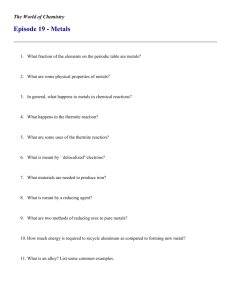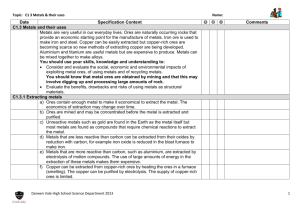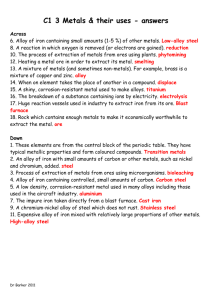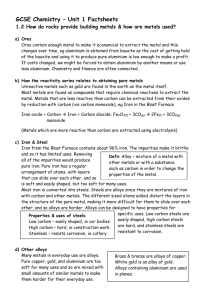C1.3_metals_and_their_uses
advertisement
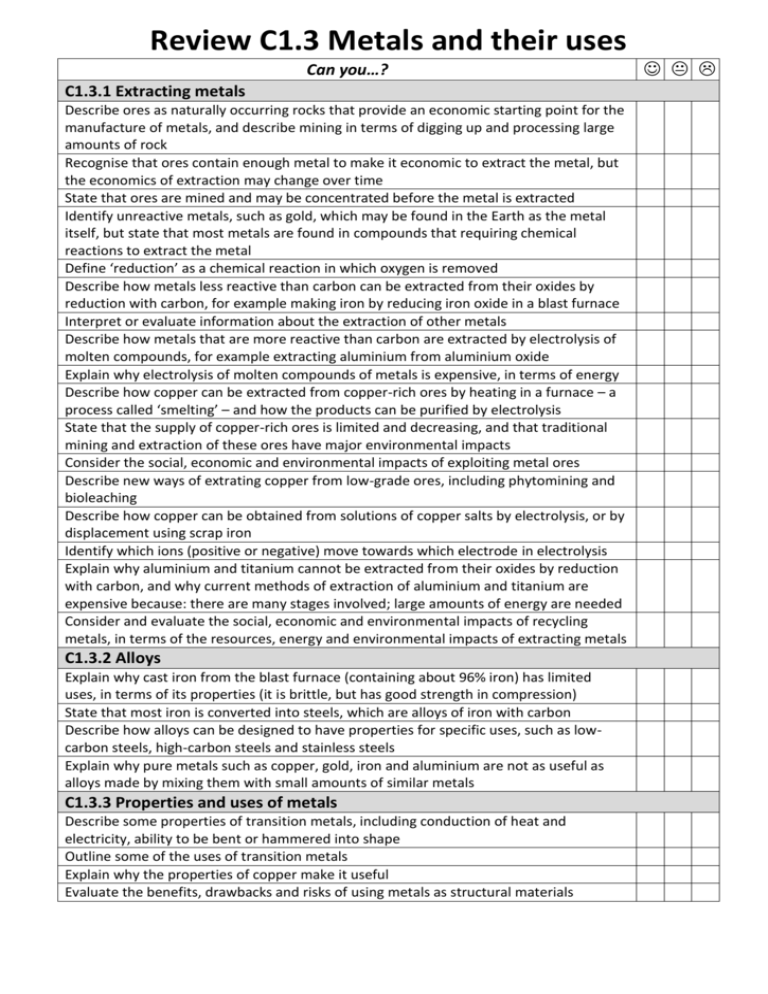
Review C1.3 Metals and their uses Can you…? C1.3.1 Extracting metals Describe ores as naturally occurring rocks that provide an economic starting point for the manufacture of metals, and describe mining in terms of digging up and processing large amounts of rock Recognise that ores contain enough metal to make it economic to extract the metal, but the economics of extraction may change over time State that ores are mined and may be concentrated before the metal is extracted Identify unreactive metals, such as gold, which may be found in the Earth as the metal itself, but state that most metals are found in compounds that requiring chemical reactions to extract the metal Define ‘reduction’ as a chemical reaction in which oxygen is removed Describe how metals less reactive than carbon can be extracted from their oxides by reduction with carbon, for example making iron by reducing iron oxide in a blast furnace Interpret or evaluate information about the extraction of other metals Describe how metals that are more reactive than carbon are extracted by electrolysis of molten compounds, for example extracting aluminium from aluminium oxide Explain why electrolysis of molten compounds of metals is expensive, in terms of energy Describe how copper can be extracted from copper-rich ores by heating in a furnace – a process called ‘smelting’ – and how the products can be purified by electrolysis State that the supply of copper-rich ores is limited and decreasing, and that traditional mining and extraction of these ores have major environmental impacts Consider the social, economic and environmental impacts of exploiting metal ores Describe new ways of extrating copper from low-grade ores, including phytomining and bioleaching Describe how copper can be obtained from solutions of copper salts by electrolysis, or by displacement using scrap iron Identify which ions (positive or negative) move towards which electrode in electrolysis Explain why aluminium and titanium cannot be extracted from their oxides by reduction with carbon, and why current methods of extraction of aluminium and titanium are expensive because: there are many stages involved; large amounts of energy are needed Consider and evaluate the social, economic and environmental impacts of recycling metals, in terms of the resources, energy and environmental impacts of extracting metals C1.3.2 Alloys Explain why cast iron from the blast furnace (containing about 96% iron) has limited uses, in terms of its properties (it is brittle, but has good strength in compression) State that most iron is converted into steels, which are alloys of iron with carbon Describe how alloys can be designed to have properties for specific uses, such as lowcarbon steels, high-carbon steels and stainless steels Explain why pure metals such as copper, gold, iron and aluminium are not as useful as alloys made by mixing them with small amounts of similar metals C1.3.3 Properties and uses of metals Describe some properties of transition metals, including conduction of heat and electricity, ability to be bent or hammered into shape Outline some of the uses of transition metals Explain why the properties of copper make it useful Evaluate the benefits, drawbacks and risks of using metals as structural materials





